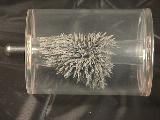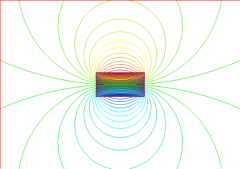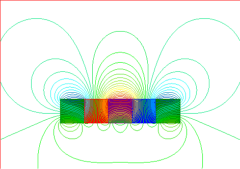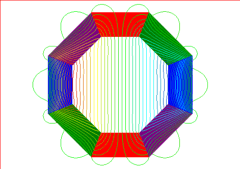


Experiments with magnets and our surroundings
Visualizing magnetic fields
How can I visualize the magnetic field? ![]()
At first, this seems like an impossible task since you can not see magnetic fields. However, there are several ways to do this.

1. The easiest way is to take a small compass and move it around within a magnetic field. The direction the compass points is tangent to the curve of the magnetic field line at any location. A nice tool for this, using a small bar magnet instead of a compass is the following I got from Arbor Scientific.

2. The next most popular method is to place the magnet (or electromagnet) under a piece of paper or light cardboard. You then sprinkle iron filings on top of the paper, tap the paper a couple of times, and watch the small filings line up along the field lines. You could spray clear Krylon over the pattern, keeping it in place. It is also possible to get tin-plated iron filings. These won't rust. Or, get a plastic box with iron filings in it, and place a magnet under the box. They will trace out the field lines. A variation of this is to use black sand which is simply very small particles of magnetite. Another variation, which isn't as messy, is to use the product, also from Arbor Scientific, called Mysterious Magnet Tube to see the iron filings surround the magnet in the middle. The iron filings stay contained within the cylinder. There are some other variations of this on the market, including having the iron filings suspended in oil.

3. Another method is to take your stapler, make a bunch of staples, and use them like big iron filings. Sprinkle them onto a piece of paper, like you do with the filings, or let them hang around on the magnet itself. A variation of this is to use BB's to do the same thing.
4. The most accurate method is to use a software package that will calculate the field in the space around a magnet or electromagnet and plot the field lines or display shaded areas corresponding to the strength of the field.
Ansoft Corporation had a great software package which can simulate the fields and forces surrounding permanent magnets and electromagnets. The following diagrams show the results of some simulations created using the Ansoft Maxwell 2D Field Simulator program. (Maxwell is a registered trademark). contact me to obtain a free copy of this Student Version of this program!!!
Here is a pdf of a Basic User Manual I created to help you use
this Student Version. (about 825kB)
Install Adobe
Reader to be able to read this file. ![]()
Helmholtz Coils or Assembly ![]()
A Helmholtz assembly is actually a specific configuration of two coils. Each coil has the same radius. Also, the coils are placed parallel to each other. The distance between the coils is the same as the radius of each coil. What makes this assembly special is that if each coil has the same current flowing through each other (by connecting them in series) and the direction of current is the same, the magnetic field within the center of the two coils changes very little as you move along the center line from one coil to the other. This is a way to create a volume with a fairly constant magnetic field throughout that volume of space.

This shows a cross section of the two coils and the field they create. The upper right dot and the lower right dot are one coil, the upper left dot and the lower left dot are the other coil. Current enters each coil at the bottom and exits at the top. The spacing between the field lines in the middle section is fairly uniform, meaning that the field strength is very constant in that area. You can easily make something like this, and test the field strength in the middle as you vary the spacing between the coils, and vary the position of the field strength sensor.
More can be done with this. If a magnet is placed within the center of the Helmholtz assembly and rotated half a turn, the response will tell you the magnetic moment. A good reference on that is here.
There are some great articles describing how to build a
supersensitive magnetometer using such an assembly, especially for tracking
changes in the earth's magnetic field due to magnetic storms on the sun.
Check out:
http://www.netdenizen.com/emagnet/
for details on calculating the field within a Helmholtz coil assembly
Halbach Array
A Halbach array is a unique arrangement of permanent magnets used to achieve a fairly uniform magnetic field within a volume of space, similar to the idea behind the Helmholtz coils assembly. It can also be an arrangement of permanent magnets used to achieve a stronger field on one side than the other, often found in ferrous metal collectors.
Compare the following.


The diagram on the left is for reference. The arrow within the magnet points to the North pole of the magnet, since this is the direction the magnetic field flows within the magnet. The diagram on the right shows what the magnetic field would look like.


The diagram on the left shows the arrangement of five permanent magnets. The diagram on the right shows the field that this arrangement will create. Notice how the field is much stronger on the top of the assembly than on the bottom of it?


The diagram on the left shows the arrangement of eight permanent magnets in an octagon. The diagram on the right shows the field that this arrangement will create. Notice how uniform the field is within the assembly (all of the field lines are just about equally spaced apart), and how weak the field is outside of the assembly.
For more information, check sites like these:
Magnets, Markets, and Magic Cylinders, by Michael Coey and Denis Weaire
A Permanent-Magnet Based Vector Vibrating Sample Magnetometer, by J.M.D. Coey, David Hurley, and Farid Bengrid
Design of an electrical machine with integrated flywheel, by Colotti Alberto, and Reichert Konrad
Can I make one big North pole?
In other words, can I make a monopole? As the name implies, a monopole is a magnet that has just one pole - either a North pole or a South pole. It doesn't matter which one, but the interesting thing is that it only has one. An equivalent in the electrical world would be an electron or proton - a particle that has just one charge (negative for the electron, positive for the proton).
I decided to try this using Maxwell, the free student version you can use to try interesting experiments with magnets and electromagnets. The idea would be to do something like gluing a bunch of magnets onto the surface of a ball (perhaps a golf ball or a baseball) in such a way that the North pole of each magnet is facing outward. This way, you would have one ball, completely covered with magnets. With all of the North poles facing away from the surface of the ball, I would have a monopole, right? Why is this so tough?
What I did was to design a wedge shaped magnet, magnetized with its North pole facing out along its wider face and its South pole facing in along its smaller face. The outer face is flat, and I made the inner face round (doesn't make any difference either way). Each one is 45 degrees of a circle, so that it takes 8 of them to make a full circle. All I have to do is place them in a circle with some space between them, and then start squeezing them closer and closer together until there is no space at all between them and I have a solid circle of magnets with North on the outside and South on the inside. OK?
Watch this: Magnets in Motion 12 (then click on the Back button of your browser to return here)
What happened? As long as there was some space between the magnets, the field lines would exit the outer flat surface of the magnet, go around the sides of it and enter the magnet at the South end. As the magnets got closer, the space for the lines got tighter. What this would look like on the outside is that there are North poles, because that's where the fields were coming from, with South poles in between them, because that's where the fields were going back in between the cracks. As soon as there was no space between the magnets at all, the fields disappeared! How can that be? It has to! Why? Remember, a magnetic field is like a rubber band. It forms a complete loop. It comes out of the North pole end of a magnet, loops around in the air or other things, and goes back into the South pole of the magnet. It then will travel through the magnet to the other end where it can pop out of the magnet again at the North pole - around and around. They don't cross each other, they don't end somewhere or start somewhere. If it can't form a loop, it can't exist. As far as anyone knows, magnetic fields only exist when current (electrons or protons - something with a charge) is moving. If the current stops, the field decays to nothing. A changing field can create a current, a moving current can create a field. That's how generators and motors work.
Here's another animation showing part of the previous
one: Magnets in Motion 13 (then click on
the Back button of your browser to return here)
What this is showing, is that as far as anyone knows, monopoles do not exist except in science fiction.